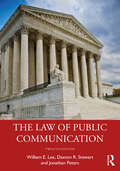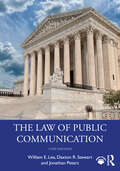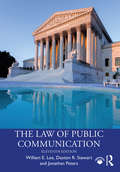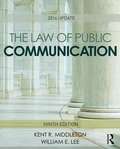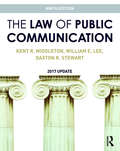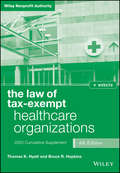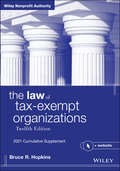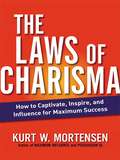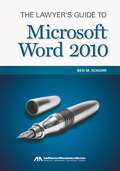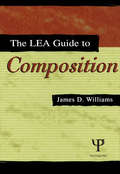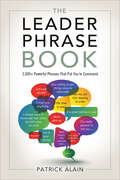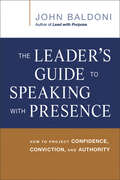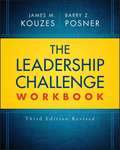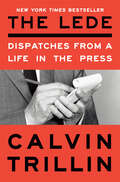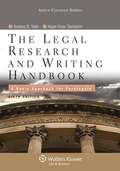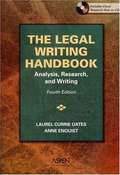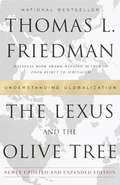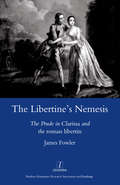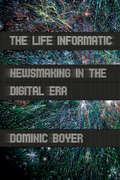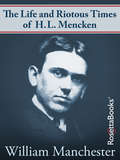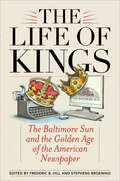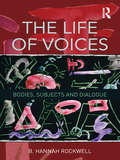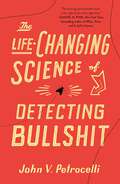- Table View
- List View
The Law of Public Communication
by William E. Lee Kent R. Middleton Daxton R. StewartNow in its tenth edition, The Law of Public Communication provides an overview of media law that includes the most current legal developments. It explains the laws affecting the daily work of writers, broadcasters, PR practitioners, photographers, and other public communicators. By providing statutes and cases in an accessible manner, even to students studying law for the first time, the authors ensure that students will acquire a firm grasp of the legal issues affecting the media. This new edition features color photos, as well as breakout boxes that apply the book’s principles to daily life. The new case studies discussed often reflect new technologies and professional practices.
The Law of Public Communication
by William E. Lee Daxton R. Stewart Jonathan PetersThe twelfth edition of this classic textbook provides an overview of communication and media law including the most current legal developments. It explains laws affecting the daily work of writers, broadcasters, public relations practitioners, photographers, bloggers and other public communicators. By providing statutes and cases in an accessible manner, even to students studying law for the first time, the authors ensure that students acquire a firm grasp of the legal issues affecting the media. The book examines legal topics such as libel, privacy, intellectual property, obscenity and access to information, considering the development and current standing of relevant laws and important cases. It examines how these laws affect public, political and commercial communication. The twelfth edition discusses hot topics such as proposals to modify Section 230 of the Communications Decency Act, net neutrality legislation, participant monitoring, the "actual malice" standard for litigation against journalists and the Julian Assange Espionage Act prosecution. It also explores social media issues, such as whether social media use by public officials constitutes a public forum, liability for defamation and the operation of Facebook’s Oversight Board. The Law of Public Communication is an ideal core textbook for undergraduate and graduate courses in communication law and mass media law. Online resources include a test bank and PowerPoint slides.
The Law of Public Communication
by William E. Lee Daxton R. Stewart Jonathan PetersThis thoroughly updated classic textbook provides an overview of communication and media law, including the most current legal developments. It explains laws affecting the daily work of writers, broadcasters, public relations practitioners, photographers, bloggers and other public communicators.By outlining statutes and cases in an accessible manner, even to students studying law for the first time, the authors ensure that readers acquire a firm grasp of the legal issues affecting the media. The book examines legal topics such as libel, privacy, intellectual property, obscenity and access to information, considering the development and current standing of relevant laws and important cases. It examines how these laws affect public, political and commercial communication. The 13th edition covers contemporary U.S. Supreme Court cases, including the true threats case Counterman v. Colorado, the Andy Warhol fair use case and the Jack Daniel's trademark parody case. It also presents the Biden administration's revision of policy on the use of subpoenas and search warrants to uncover reporters' confidential sources along with the gag orders imposed by courts handling criminal and civil trials in which Donald Trump is a defendant. Further cases explored include the attacks by legislatures against the LGBTQ community, exemplified by a Tennessee law banning drag performances, and the emerging issues presented by artificial intelligence and the content moderation policies of social media platforms.The Law of Public Communication is an ideal core textbook for undergraduate and graduate courses in communication law and mass media law.A test bank for instructors is available at www.routledge.com/9781032676388
The Law of Public Communication, 11th Edition
by William E. Lee Daxton Stewart Jonathan PetersThe eleventh edition of this classic textbook provides an overview of communication and media law that includes the most current legal developments. It explains the laws affecting the daily work of writers, broadcasters, PR practitioners, photographers and other public communicators. By providing statutes and cases in an accessible manner, even to students studying law for the first time, the authors ensure that students will acquire a firm grasp of the legal issues affecting the media. This new edition features discussions of hot topics such as the prosecution of WikiLeaks founder Julian Assange for Espionage Act violations, the U.S. Supreme Court's decision in Iancu v. Brunetti addressing the registration of offensive trademarks, revenge porn, FTC guidelines on social media influencers and efforts by social media platforms to develop coherent approaches to misinformation. The Law of Public Communication is an ideal core textbook for undergraduate and graduate courses in communication law and mass media law. A downloadable test bank is available for instructors at www.routledge.com/9780367476793.
The Law of Public Communication: 2016 Update
by William E. Lee Daxton Stewart Kent R. MiddletonThe Law of Public Communication provides an overview of media law that includes the most current legal developments today. It explains the laws affecting the daily work of writers, broadcasters, advertisers, cable operators, Internet service providers, public relations practitioners, photographers, bloggers, and other public communicators. Authors Kent R. Middleton, William E. Lee, and Daxton R. Stewart take students through the basic legal principles and methods of analysis that allow students to study and keep abreast of the rapidly changing field of public communication. By providing statutes and cases in a cohesive manner that is understandable, even to students studying law for the first time, the authors ensure that students will acquire a firm grasp of the legal issues affecting the media. This 2017 Update brings the Ninth Edition up to date with the most recent cases and examples affecting media professionals and public communicators.
The Law of Public Communication: 2017 Update
by William E. Lee Daxton Stewart Kent R. MiddletonThe Law of Public Communication provides an overview of media law that includes the most current legal developments today. It explains the laws affecting the daily work of writers, broadcasters, advertisers, cable operators, Internet service providers, public relations practitioners, photographers, bloggers, and other public communicators. Authors Kent R. Middleton, William E. Lee, and Daxton R. Stewart take students through the basic legal principles and methods of analysis that allow students to study and keep abreast of the rapidly changing field of public communication. By providing statutes and cases in a cohesive manner that is understandable, even to students studying law for the first time, the authors ensure that students will acquire a firm grasp of the legal issues affecting the media. This 2017 Update brings the Ninth Edition up to date with the most recent cases and examples affecting media professionals and public communicators.
The Law of Tax-Exempt Healthcare Organizations: 2007 Cumulative Supplement (Wiley Nonprofit Authority #253)
by Bruce R. Hopkins Thomas K. HyattGet up to date on tax-exempt healthcare law and relevant issues The Law of Tax-Exempt Healthcare Organizations, Fouth Edition provides complete and comprehensive information and analysis in a single volume - this is the e-book version. Tackling complex legal issues with plain-English explanations and the appropriate citations, this guide is a must-have resource for organizations and their advisors. Healthcare law is a complex field, and keeping up with the frequent changes to federal law is itself a full time job. This book eliminates the need for extended research time by collecting the relevant guidelines into one place.
The Law of Tax-Exempt Organizations, + Website: 2021 Cumulative Supplement (Wiley Nonprofit Authority Ser.)
by Bruce R. HopkinsRemain current on every critical development in the law of tax-exempt organizations in the United States The 2021 Cumulative Supplement to the twelfth edition of The Law of Tax-Exempt Organizations covers every major change to the legislation, regulations, and case law governing tax-exempt organizations in the United States in 2021. Lawyers, accountants, and consultants serving non-profits, charities, and other tax-exempt organizations will find up-to-the-moment guidance and advice on serving these ubiquitous institutions, as will the directors, executives, and managers of the organizations themselves.
The Laws of Charisma: How to Captivate, Inspire, and Influence for Maximum Success
by Kurt W. MortensenSome people have the ability to enter a room and draw instant attention, effortlessly exuding charm, radiating energy and a commanding presence. That enviable quality is called charisma! And those who have it are better able to influence what gets done and ultimately achieve what they want. To some extent, it's innate - but with a few simple principles anyone can develop a more charismatic and compelling presence. Filled with practical, powerful tools, exercises, and assessments, "The Laws of Charisma" explores the vital skills and traits anyone can use to earn trust, generate interest, and motivate others. Focusing on the four core elements of charisma, this book shows readers how to: radiate confidence, passion, power, and optimism; combine purpose, creativity, competence, and focus to inspire commitment; influence others by improving communication skills; and persuade and empower anyone by creating instant rapport. Charisma is the key that will unlock the door to improved relationships, greater income, and enhanced success in every area of life. "The Laws of Charisma" is all anyone needs to bring out the charismatic person within.
The Lawyer's Essential Guide to Writing: Proven Tools and Techniques
by Marie BuckleyThe Lawyer's Essential Guide to Writing is a readable, concrete guide to contemporary legal writing. Based on Marie Buckley's years of experience coaching lawyers, this book provides a systematic approach to all forms of written communication, from memoranda and briefs to e-mail and blogs. The book sets forth three principles for powerful writing and shows how to apply those principles to develop a clean and confident style.
The Lawyer's Guide to Microsoft® Word 2010
by Ben M. SchorrThis handy reference includes clear explanations, legal-specific descriptions, and time-saving tips for getting the most out of Microsoft Word®--and customizing it for the needs of today's legal professional. Focusing on the tools and features that are essential for lawyers in their everyday practice, The Lawyer's Guide to Microsoft® Word 2010 explains in detail the key components to help make you more effective, more efficient, and more successful.
The Lea Guide To Composition
by James D. WilliamsBasic text for freshman composition courses. Draws on the most significant theory, strategy, and techniques in composition studies. Emphasizes writing as a vehicle for learning.
The Leader Phrase Book: 3,000+ Powerful Phrases That Put You In Command
by Patrick AlainEasily find the right words to respond like a leader in any situation, communicate effectively, and make your way to success.The Leader Phrase Book contains more than 3,000 dynamic phrases that will enable you to prevail in virtually all of life’s important situations. You will be in command of your words and always stay ahead of the game. With this passport to success, you will begin a new journey on which you are among the charismatic, the untouchable . . . the elite.This easy-to-use reference book will give you a new image you can take pride in helping you to quickly reach your full leadership potential. You will have all the weapons to effectively succeed whenever vibrant, forceful language is required. It works like magic!The Leader Phrase Book will teach you how to:• Speak like a leader• Master all conversations• Attain a charismatic presence• Gain the respect of others• Achieve a lightning-fast rhetoric• Find the right phrases instantly• Argue effectively• Be the envy of all you meetThe Leader Phrase Book is the culmination of ten years of Patrick’s personal research on how leaders communicate. It is the summation of his efforts to share one of the most invaluable skills in life: “how to put yourself in command.”Praise for The Leader Phrase Book“This refreshing and practical tool will help to enlarge, promote, and articulate the world of communication.” —Cristina Roggero, Pepperdine University professor of literature“An indispensable tool to help you become quickly fluent in phrases that put you ahead in the marketplace.” —Tony Azar, Homeland Security Chief Engineer“A must read for anyone who wants to move ahead in business.” —Jami Levesque, technical director of 300 and Transformers 3
The Leader's Guide to Speaking with Presence: How to Project Confidence, Conviction, and Authority
by John BaldoniWhether in a meeting or a presentation, a watercooler conversation or a formal speech, a leader&’s most important job is to.Your idea may be groundbreaking. The potential profits might be exhilarating. The time to act may be right now, but if you&’re not able to craft and deliver a clear message that doesn&’t lead the audience to gain your perspective, that can be the difference between your pitch being transformational and becoming forgettable.Executive coach and leadership expert John Baldoni provides this concise tool kit containing more than 100 practical tips for creating and communicating meaningful messages with presence and authority.In The Leader's Guide to Speaking with Presence, you will discover how to:Present their ideas clearly and provide contextRadiate confidence and put the audience at easeRefine their deliveryUse stories to inform, involve, and inspireLeverage the energy of any roomConvey optimism tempered with reality to gain buy-inTurn PowerPoint presentations into performancesWhen a leader learns to own the room with an authentic and persuasive speech, the audience will become putty in their hands. The Leader's Guide to Speaking with Presence helps leaders achieve the kind of genuine presence that evolves into lasting trust and quantifiable influence.
The Leadership Challenge Workbook (J-B Leadership Challenge: Kouzes/Posner)
by James Kouzes Barry Posner<p>The Leadership Challenge Workbook offers practical tools for applying The Five Practices of Exemplary Leadership® in real-life business situations. As the companion to The Leadership Challenge, this workbook provides essential hands-on guidance for planning, implementation, people-management, and more. This new revised third edition has been updated to match The Leadership Challenge Sixth Edition text. It includes easy-to-use worksheets to simplify planning and collectively assemble into a clear blueprint for moving forward. By focusing on the notion of leadership development as a journey rather than an event, this interactive guide provides critical insight through a proven, systematic process. <p>Implementing big ideas requires skillful change leadership—and any successful, sustainable change begins with thorough, practical planning. This workbook helps you map out a plan and put it into action, with tools that help clarify your thinking and translate your big ideas into concrete strategies.</p>
The Lede: Dispatches from a Life in the Press
by Calvin TrillinNEW YORK TIMES BESTSELLER • A fascinating portrait of journalism and the people who make it, told through pieces collected from the incomparable six-decade career of bestselling author and longtime New Yorker writer Calvin Trillin&“The Lede contains profiles . . . that are acknowledged classics of the form and will be studied until A.I. makes hash out of all of us.&”—Dwight Garner, The New York TimesI&’ve been writing about the press almost as long as I&’ve been in the game. At some point, it occurred to me that disparate pieces from various places in various styles amounted to a picture from multiple angles of what the press has been like over the years since I became a practitioner and an observer.Calvin Trillin has reported serious pieces across America for The New Yorker, covered the civil rights movement in the South for Time, and written comic verse for The Nation. But one of his favorite subjects over the years—a superb fit for his unique combination of reportage and humor—has been his own professional environment: the American press.In The Lede, Trillin gathers his incisive, often hilarious writing on reporting, reporters, and their world. There are pieces on a legendary crime reporter in Miami and on an erudite film critic in Dallas who once a week transformed himself from a connoisseur of the French nouvelle vague into a fan of movies like Mother Riley Meets the Vampire. Trillin writes about the paucity of gossip columns in Russia, the icebreaker he'd use if he met one of his subjects socially (e.g.: &“You must be wondering why I referred to you in Time as a dork robot&”), and the origins of a publication called Beautiful Spot: A Magazine of Parking.Uniting all of this is Trillin&’s signature combination of empathy, humor, and graceful prose. The Lede is an invaluable portrait of one our fundamental American institutions from a master journalist.
The Legal Research and Writing Handbook: A Basic Approach for Paralegals (6th Edition)
by Andrea B. Yelin Hope Viner SambornThe highly successful textbook on research and writing makes every step of the process accessible to paralegal students. The authors provide effective research tools, practical strategies and an efficient procedure for researching the law with both traditional and electronic sources. Step-by-step instruction leads students through each stage of activity, from prewriting to revising, and covers the IRAC method, legal memoranda, letters, and more. Invaluable pedagogy features examples, exhibits, expert writing tips,exercises, practice tips, ethics alerts, and web resources. Detailed subheadings provide quick access to topics, and appendices on helpful topics such as Shepardizing and Cite Checking, Citation and Sample Memoranda round out the presentation. The Student Workbook provides for extensive practice,sharpening research and writing skills. Thoroughly revised, the Sixth Edition presents new sample pages and updated exercises. Citation coverage has been updated to the 4th edition of ALWD and the 19th edition of The Bluebook . Inclusion of all the latest changes in legal research led to the revision of references, links, and examples. Students are now given more coaching on the practical aspects of outlining. The Instructor's Manual has expanded explanations, and answers to exercises and questions have been made clearer and more accessible. Hallmark features of The Legal Research and Writing Handbook:Accessible coverage of every step of the research and writing process Research tools and strategies teach an efficient process cover traditional and electronic sources Step-by-step instruction in legal writing process prewriting strategies to revising the IRAC method legal memoranda, letters, and more Excellent pedagogy examples and exhibits expert writing tips exercises practice tips ethics alerts web resources Detailed subheadings for quick access to topics Helpful appendices Shepardizing and Cite Checking Citation Sample Memoranda Student Workbook-extensive practice in research and writing skills ; Thoroughly updated, the revised Sixth Edition presents:New sample pages Citation coverage updated to 4th edition of ALWD and 19th edition of The Bluebook Latest changes in legal research Revised and updated material throughout:references links examples exercises More detail on practical aspects of outlining Thorough revision of the Instructor's Manual expanded explanations cogent and accessible answers to exercises and questions*Instructor's Manuals are a professional courtesy offered to professors only. For more information or to request a copy, please contact Wolter's Kluwer Law & Business at 800.529.7545 or examcopy@wolterskluwer.com.
The Legal Writing Handbook: Analysis, Research, and Writing
by Anne Enquist Laurel Currie OatesStudents and professors will welcome this new edition of the only text for legal writing and research that covers all three key components of the first-year course -- research, writing, and analysis.
The Lexus and the Olive Tree: Understanding Globalization
by Thomas L. FriedmanFrom one of our most perceptive commentators and winner of the National Book Award, a comprehensive look at the new world of globalization, the international system that, more than anything else, is shaping world affairs today. As the Foreign Affairs columnist for The New York Times, Thomas L. Friedman has traveled the globe, interviewing people from all walks of contemporary life: Brazilian peasants in the Amazon rain forest, new entrepreneurs in Indonesia, Islamic students in Teheran, and the financial wizards on Wall Street and in Silicon Valley. Now Friedman has drawn on his years on the road to produce an engrossing and original look at globalization. Globalization, he argues, is not just a phenomenon and not just a passing trend. It is the international system that replaced the Cold War system; the new, well-greased, interconnected system: Globalization is the integration of capital, technology, and information across national borders, in a way that is creating a single global market and, to some degree, a global village. Simply put, one can't possibly understand the morning news or one's own investments without some grasp of the system. Just one example: During the Cold War, we reached for the hot line between the White House and the Kremlin--a symbol that we were all divided but at least the two superpowers were in charge. In the era of globalization, we reach for the Internet--a symbol that we are all connected but nobody is totally in charge. With vivid stories and a set of original terms and concepts, Friedman offers readers remarkable access to his unique understanding of this new world order, and shows us how to see this new system. He dramatizes the conflict of "the Lexus and the olive tree"--the tension between the globalization system and ancient forces of culture, geography, tradition, and community. He also details the powerful backlash that globalization produces among those who feel brutalized by it, and he spells out what we all need to do to keep the system in balance. Finding the proper balance between the Lexus and the olive tree is the great drama of he globalization era, and the ultimate theme of Friedman's challenging, provocative book--essential reading for all who care about how the world really works.
The Libertine's Nemesis: The Prude in Clarissa and the Roman Libertin
by James FowlerWhat is the role of the prude in the roman libertin? James Fowler argues that in the most famous novels of the genre (by Richardson, Crebillon fils, Laclos and Sade) the prude is not the libertine's victim but an equal and opposite force working against him, and that ultimately she brings retribution for his social, erotic and philosophical presumption. In a word, she is his Nemesis. He is vulnerable to her power because of the ambivalence he feels towards her; she is his ideological enemy, but also his ideal object. Moreover, the libertine succumbs to an involuntary nostalgia for the values of the Seventeenth Century, which the prude continues to embody through the age of Enlightenment. In Crebillon fils and Richardson, the encounter between libertine and prude is played out as a skirmish or duel between two individuals. In Laclos and Sade, the presence of female libertines (the Marquise de Merteuil and Juliette) allows that encounter to be reenacted within a murderous triangle.
The Life Informatic
by Dominic BoyerNews journalism is in the midst of radical transformation brought about by the spread of digital information and communication technology and the rise of neoliberalism. What does it look like, however, from the inside of a news organization? In The Life Informatic, Dominic Boyer offers the first anthropological ethnography of contemporary office-based news journalism. The result is a fascinating account of journalists struggling to maintain their expertise and authority, even as they find their principles and skills profoundly challenged by ever more complex and fast-moving streams of information. Boyer conducted his fieldwork inside three news organizations in Germany (a world leader in digital journalism) supplemented by extensive interviews in the United States. His findings challenge popular and scholarly images of journalists as roving truth-seekers, showing instead the extent to which sedentary office-based "screenwork" (such as gathering and processing information online) has come to dominate news journalism. To explain this phenomenon Boyer puts forth the notion of "digital liberalism"-a powerful convergence of technological and ideological forces over the past two decades that has rebalanced electronic mediation from the radial (or broadcast) tendencies of the mid-twentieth century to the lateral (or peer-to-peer) tendencies that dominate in the era of the Internet and social media. Under digital liberalism an entire regime of media, knowledge, and authority has become integrated around liberal principles of individuality and publicity, both unmaking and remaking news institutions of the broadcast era. Finally, Boyer offers some scenarios for how news journalism will develop in the future and discusses how other intellectual professionals, such as ethnographers, have also become more screenworkers than fieldworkers.
The Life and Riotous Times of H.L. Mencken
by William Manchester&“Written with verve, intellectual sophistication, and a prickly wit worthy of its eminent subject. . . . A first-class piece of literate entertainment&” (The New Yorker). Before he went on to become a celebrated biographer and historian, renowned for such works as A World Lit Only by Fire, American Caesar, and The Last Lion, William Manchester worked as a reporter for the Baltimore Sun in the 1940s—and it was there that he met fellow journalist H. L. Mencken. This book tells the story of conservative, anarchist H. L. Mencken&’s life in compelling, intimate detail—and offers a uniquely personal look at the influential cultural critic and satirist who cofounded the magazines the American Mercury and the Smart Set and became a legend for his sharp and highly quotable wit.
The Life of Kings: The Baltimore Sun and the Golden Age of the American Newspaper
by Frederic B. Hill Stephens BroeningIn an age when local daily papers with formerly robust reporting are cutting sections and even closing their doors, the contributors to The Life of Kings celebrate the heyday of one such paper, the Baltimore Sun, when it set the agenda for Baltimore, was a force in Washington, and extended its reach around the globe. Contributors like David Simon, creator of HBO’s The Wire, and renowned political cartoonist Kevin Kallaugher (better known as KAL), tell what it was like to work in what may have been the last golden age of American newspapers -- when journalism still seemed like “the life of kings” that H.L. Mencken so cheerfully remembered. The writers in this volume recall the standards that made the Sun and other fine independent newspapers a bulwark of civic life for so long. Their contributions affirm that the core principles they followed are no less imperative for the new forms of journalism: a strong sense of the public interest in whose name they were acting, a reverence for accuracy, and an obligation
The Life of Voices: Bodies, Subjects and Dialogue
by B. Hannah RockwellThe Life of Voices illustrates how human voices have special significance as the place where mind and body collaborate to produce everyday speech. Hannah Rockwell links Russian semiotician Mikhail Bakhtin’s philosophy of dialogue with French phenomenologist Maurice Merleau-Ponty’s views of the relation between bodies and speech expression to develop a unique theory of communication and bodies. By introducing readers to actual human subjects speaking about how their identities have been shaped and transformed through time, the author explores how discourses reproduce ideology and social power relations. Readers are challenged to consider complex influences between human subjects and institutionalized discourses through critical-interpretive analyses of transcribed speech. The Life of Voices has an interdisciplinary flair grounded in careful research. Scholars in communication, sociology, philosophy, psychology, linguistics, anthropology, gender studies and identity politics will find valuable insights, methods and examples in this work. It is essential reading for anyone who is interested in discourse studies and the body’s relationship to speech or human identity formation.
The Life-Changing Science of Detecting Bullshit
by John V. PetrocelliExpanding upon his viral TEDx Talk, psychology professor and social scientist John V. Petrocelli reveals the critical thinking habits you can develop to recognize and combat pervasive false information that harms society in The Life-Changing Science of Detecting Bullshit.Bullshit is the foundation of contaminated thinking and bad decisions leading to health consequences, financial losses, legal consequences, broken relationships, and wasted time and resources.No matter how smart we believe ourselves to be, we’re all susceptible to bullshit—and we all engage in it. While we may brush it off as harmless marketing sales speak or as humorous, embellished claims, it’s actually much more dangerous and insidious. It’s how Bernie Madoff successfully swindled billions of dollars from even the most experienced financial experts with his Ponzi scheme. It’s how the protocols of Mao Zedong’s Great Leap Forward resulted in the deaths of 36 million people from starvation. Presented as truths by authority figures and credentialed experts, bullshit appears legitimate, and we accept their words as gospel. If we don’t question the information we receive from bullshit artists to prove their thoughts and theories, we allow these falsehoods to take root in our memories and beliefs. This faulty data affects our decision making capabilities, sometimes resulting in regrettable life choices. But with a little dose of skepticism and a commitment to truth seeking, you can build your critical thinking and scientific reasoning skills to evaluate information, separate fact from fiction, and see through bullshitter spin. In The Life-Changing Science of Detecting Bullshit, experimental social psychologist John V. Petrocelli provides invaluable strategies not only to recognize and protect yourself from everyday bullshit, but to accept your own lack of knowledge about subjects and avoid in engaging in bullshit just for societal conformity.With real world examples from people versed in bullshit who work in the used car, real estate, wine, and diamond industries, Petrocelli exposes the red-flag warning signs found in the anecdotal stories, emotional language, and buzzwords used by bullshitters that persuade our decisions. By using his critical thinking defensive tactics against those motivated by profit, we will also learn how to stop the toxic misinformation spread from the social media influencers, fake news, and op-eds that permeate our culture and call out bullshit whenever we see it.

